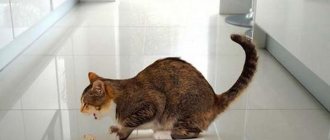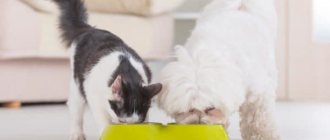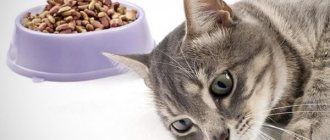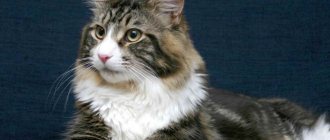Symptoms and signs
Poisoning in cats is rare. Animals have good olfactory qualities, so they rarely eat a toxic substance. However, intoxication cannot be ruled out. The signs and symptoms of poisoning are not difficult to recognize; any owner should know them.
Signs:
- The animal exhibits weakness, apathy, and lacks the desire to play;
- Signs of indigestion appear - diarrhea, vomiting, difficulty swallowing;
- Salivation increases, appetite disappears;
- Violation of the respiratory process, heavy inhalations and exhalations;
- Increased pulse, heartbeat;
- Temperature increase;
- Presence of convulsive manifestations;
Any owner notices that the animal’s behavior has changed. When a cat is poisoned, it becomes apathetic or the pet becomes agitated.
Intoxication in cats can be food or non-food. In the first case, a toxic substance enters the animal’s body. Non-food poisoning is diagnosed upon contact with any substance - carbon monoxide, toxic liquids. In such a case, other organs suffer, not the esophagus.
Causes
In case of food poisoning, the cause may lie in the animal’s eating behavior. Cats often do not even chew their food, but swallow it whole, or catch and eat poisoned rats and mice. The poison can enter the body when the pet licks itself. Non-food causes:
Consequences of an insect bite in a cat.
- contact poison contact with skin;
- vapors, gases;
- insect bites;
- fumes
Some toxic substances are odorless, so the animal may not smell them, or not pay attention to the bite of some harmless midge or a drop of poison that gets on the fur or skin. The following symptoms of intoxication may occur:
- convulsions;
- heart rhythm disturbances;
- disorientation;
- decreased metabolic rate;
- fainting.
[custom_ads_shortcode3]
First aid for cat poisoning
If signs of poisoning appear in a cat, the animal is taken to the veterinarian. If this cannot be done immediately, then the injured animal is given first aid. It includes a set of actions aimed at cleansing the body of toxins and restoring the functioning of the body.
What to do:
- In case of poisoning, gastric lavage is done. Water is injected into the cat's throat through a syringe, and the root of the tongue is pressed, provoking vomiting. It is permissible to use potassium permanganate only with the permission of a specialist. When self-treating poisoning, incorrect calculation of the concentration of the substance is possible.
- After washing the animal’s stomach, you can give it sorbents to drink. Such medications will speed up the removal of toxins from the body in case of poisoning. To do this, use a polysorbate solution - a quarter of a teaspoon is diluted with a glass of water. Two small spoons of solution are enough for the animal.
- You can use activated carbon - one tablet per tablespoon of water, give the mixture to the cat to drink.
- Using saline laxatives for poisoning will speed up the process of removing toxins from the intestines.
- Be sure to drink plenty of fluids to avoid dehydration.
After the first steps, it is recommended to show the animal to doctors to avoid the development of negative symptoms. The greatest danger is poisoning from rat poison. In case of intoxication with this substance, help is needed immediately to avoid the death of the pet.
In veterinary clinics, the furry patient is administered various medications. Self-treatment of poisoning using unknown medications is not allowed. Only an experienced doctor knows how much and what is permissible to use in a particular case.
What to feed a cat after poisoning
How to feed a cat?
An adult animal can go without food for a full day without harm to health; kittens need to eat after twelve hours. On the first day after poisoning with rat poison and other substances, it is not recommended to give the cat any food; it is important to ensure constant access to clean water.
On the second day it is allowed to give separate foods.
- Rice water or gruel from well-cooked cereals;
- Liquid food for weakened animals;
- During hospitalization, various nutrient solutions are administered;
At home, you need to carefully monitor the animal’s reaction to any food. After vomiting and diarrhea stop, the cat can be given low-fat broth. It is not recommended to mix natural and purchased food, as such a combination leads to irritation of the intestinal walls.
Be sure to praise the animal for every bite eaten to stimulate appetite. After poisoning, many cats lose weight. If the pet was well-fed and lost a little weight, then it is not recommended to fatten it. For a weakened cat, various foods are introduced into the diet.
What you can do:
- Buckwheat and rice groats. They are used to cook porridge and grind it into puree before serving.
- Homemade low-fat cottage cheese, provided that the cat tolerates lactose normally.
- Pieces of unsalted cheese in small portions are used to stimulate appetite.
- You can give your cat baby food made from meat, without sugar.
Dry food is not given to cats during the first days of recovery. Hard granules irritate the inflamed mucous membranes of the stomach and intestines. It is better to replace such food with pates or wet food.
If a cat does not eat, it is not recommended to force it to eat. However, if you have a long-term lack of appetite, it is better to go to the hospital.
What to feed a kitten if it is poisoned? In babies, the digestive tract is not fully formed, so negative reactions develop faster. In case of intoxication of kittens, the same procedures are carried out, feeding is carried out in the same way, but in smaller dosages. It is better to include more fermented milk products and less meat in your diet.
Feeding cats that are vomiting: natural foods and dry food
A pet needs dietary nutrition if vomiting occurs more than 3 times a day, regardless of its cause. The pet's diet consists of dishes that are easily digestible, foods that are properly processed, or switched to veterinary food to restore normal digestion.
Basic rules for feeding a cat when vomiting
It is difficult to independently understand the reasons for the regular rejection of food in a cat. Vomiting occurs as a symptom of a host of serious diseases, but it also happens in a healthy cat due to accumulations of hair, overeating, eating food quickly, stress, intolerance to certain foods or food.
If it is not possible to take the animal to the clinic, first aid is provided at home. Food is removed for 12–24 hours; it provokes new urges and does not have time to be absorbed. Liquid also does not stay in the stomach, but the losses need to be replenished. The pet is given water from a pipette in small portions every hour or a NaCl subcutaneously in the withers area.
At the end of therapeutic fasting, the cat’s well-being is assessed. Urgent veterinary care is required if the nausea does not stop, the temperature rises, the cat remains lethargic and withdraws. When health improves, when the urges are reduced and no other negative symptoms appear, the pet is transferred to a gentle diet:
- Portions are reduced by half, but fed more often, 4–5 times a day.
- Products are thermally processed, raw and fried foods are removed so as not to provoke another urge.
- The pet is fed food with a mushy consistency. In this form, it envelops the inner walls of the stomach, facilitating the absorption of nutrients.
- Animals on ready-made food are transferred to therapeutic lines for cats with gastrointestinal disorders.
- Follow the drinking regime: until the urge completely stops, drink from a syringe without a needle or pipette every 2 hours.
If an intolerance to food components is suspected, the cat is placed on an elimination diet, as with a food allergy.
Processing makes food easier to digest. The meat is freed from fatty layers, boiled in pieces, chopped in a blender, and served with broth. Vegetables and cereals are boiled in water or meat broth and pureed.
The diet includes foods that are easy to digest:
| Can: | It is forbidden: |
|
|
Often the cause of repeated vomiting is food intolerance; it occurs when there is a lack of enzymes to process food components; you can verify this after transferring your pet to a monoprotein diet.
One type of meat and cereal that is unfamiliar to the pet is left in the diet for 9–12 weeks. If the urge stops, the usual food is gradually returned and the cat’s well-being is monitored.
Products are administered once every 2 weeks; if vomiting occurs after trying the next dish, it is excluded from the diet.
Medicines are not given on your own; they are prescribed by a doctor. Depending on the cause, antiemetics, antispasmodics, and gastroprotectors are used. Without the recommendations of a veterinarian, the animal can be given decoctions of plants with enveloping, antispasmodic, and anti-inflammatory properties.
These include:
- cordate linden;
- mint and lemon balm;
- fennel;
- marsh calamus;
- St. John's wort;
- medicinal chamomile.
The preparations are infused in boiling water and 5 ml are poured through a pipette three times a day. To restore strength, injections of vitamins are administered: ascorbic acid, group B.
Special dry food
Veterinary lines for animals with digestive problems are developed to reduce the load on the gastrointestinal tract and include dry and wet food. They use 1-2 protein sources; The ingredients are carefully processed to make them easier to digest. For the first 3 days, it is better to give the cat semi-liquid food, soften the granules in water.
The following types are suitable for restoring digestion:
- Animonda Integra Protect Adult Intestinal includes hydrolyzed chicken protein and gluten-free cereal - rice. The product has a good composition of minerals: their ratio prevents the formation of sand in the urinary organs. The increased sodium and potassium content compensates for the losses. Prebiotics FOS and MOS support healthy microflora. Fish oil helps strengthen the coat.
- Forza10 Intestinal Active is created from fishmeal. MOS lactoenzymes and prebiotics help restore the gastrointestinal mucosa. The products contain useful phytocomponents: chestnut extract, rose hips and plantain - a source of natural polysaccharides.
- Monge Vet Solution Gastrointestinal contains freeze-dried pork and salmon protein. Cereal crops are replaced by cassava and potatoes; useful additional components include taurine, horse chestnut extract, and dried melon pulp.
- Royal Canin Gastro Intestinal GI 32 is made from dehydrated poultry protein, which is further processed to make it easier to digest. A reduced amount of fat reduces the load on the pancreas. Prebiotics, psyllium seeds, Omega-3 fatty acids accelerate the recovery of the digestive system.
- Trovet Hepatic HLD is recommended for liver diseases that are accompanied by vomiting. Sources of animal protein include lamb and pork, carbohydrates include corn and rice, the amount of L-carnitine and taurine is increased.
When choosing food, it is better to consult a veterinarian and adhere to the recommended daily diet:
| Name | Cat body weight | Daily norm |
| Animonda Integra | 2 | 40 |
| 3 | 45 | |
| 4 | 60 | |
| 5 | 75 | |
| 6 | 80 | |
| 8 | 90 | |
| 10 | 120 | |
| Forza10 | ≤ 2,5 | 25 – 35 |
| 2,5 – 3,5 | 35 – 45 | |
| 3,5 – 4,5 | 45 – 60 | |
| 4,5+ | 60+ | |
| Monge | 2 | 32 |
| 3 | 43 | |
| 4 | 65 | |
| 5 | 65 | |
| 6 | 85 | |
| 8 | 98 | |
| 10 | 115 | |
| Royal Canin | 0,5 – 1 | 15 – 20 |
| 0,9 – 2,3 | 20 – 33 | |
| 2,3 – 3,2 | 33 – 41 | |
| 3,2 – 4,5 | 41 – 60 | |
| 4,5 – 6 | 60 – 98 | |
| 6 – 7,3 | 98 – 120 | |
| Truvit | 2 – 3 | 35 – 50 |
| 3 – 5 | 50 – 70 | |
| 5 – 7 | 70 – 90 |
Medicinal food is used from 1 week to 3 months, depending on the condition of the cat. The daily norm is distributed over 3–4 feedings.
Regular vomiting occurs in animals with sensitive digestion.
For such cats, food marked Sensitive is suitable:
- Josera SensiCat is made from turkey and duck meal, with rice and corn as carbohydrates. Dietary fiber prevents the formation of hairballs in the stomach and facilitates natural elimination.
- Arden Grande Sensitive is created on the basis of white fish and potatoes, there are no cereal components. Natural sources of Omega 3-6 are chicken and salmon fat. Prebiotics and a rare component of nucleotides are added to the granules; they improve digestion, accelerate cell renewal, and strengthen the immune system.
- Grandorf Sensitive is made from dehydrated herring, cod and turkey, and includes a single source of carbohydrates - sweet potato. Natural prebiotics – brewer’s yeast, chicory – are added to the feed. Antarctic krill becomes an additional source of vitamins and Omegas. Fiber consists of dried carrots, apples, and spinach.
- Hill's Sensitive Stomach Formula Adult is made from chicken meal, rice, whole dried eggs, and the source of fiber is oat fiber. The correct proportions of magnesium and phosphorus prevent the development of urolithiasis. Increased levels of antioxidants reduce oxidative processes in cells and support immunity.
- Sanabelle Sensitive Lamb & Rice includes raw poultry, lamb meal, carbohydrates - sorghum and rice. The food contains useful ingredients - flax seed, dry chicory. The quality is reduced by the presence of cellulose, which is added as fiber but is not suitable for animals with sensitive stomachs.
Consumption rates are indicated on the packages:
| Name | Cat body weight | Daily norm |
| Hills | 2 | 30 – 40 |
| 3 | 40 – 55 | |
| 4 | 50 – 70 | |
| 5 | 60 – 80 | |
| 6 | 65 – 95 | |
| Yozera | 2 – 3 | 25 – 40 |
| 3 – 4 | 40 – 55 | |
| 4 – 5 | 55 – 70 | |
| 5 – 7 | 70 – 100 | |
| Arden Grange | 1 | 28 |
| 2 | 45 | |
| 3 | 59 | |
| 4 | 72 | |
| 5 | 83 | |
| 6 | 94 | |
| Grandorf | 1,5 – 3 | 20 – 45 |
| 4 – 5 | 55 – 65 | |
| 6 – 8 | 75 – 95 | |
| Sanabel | 2 – 3 | 40 – 55 |
| 4 – 5 | 65 – 75 | |
| 6 – 7 | 85 – 95 | |
| 8 – 9 | 105 – 115 | |
| 10 – 11 | 120 – 130 | |
| 12 – 13 | 135 – 145 |
The daily ration is divided into 2 feedings; it can be changed depending on the needs and mobility of the cat. Therapeutic nutrition stops attacks of vomiting, but if the causes are serious, you will need the help of a doctor.
Source: https://koshek.ru/kormlenie-koshek-pri-rvote.html
Drinking regimen during intoxication
During the recovery period after poisoning, it is important to control the cat’s drinking regime. Water relieves symptoms of dehydration and helps normalize fluid and salt balance. The pet must have free access to a container of clean water.
It is allowed to place bowls with liquid throughout the room so that a weakened animal is able to reach them. The owner is advised to keep an eye on the cat; excessive drinking often provokes vomiting.
If the cat is not able to drink on its own, then water is given using a syringe or syringe. It is allowed to use different decoctions of medicinal herbs, but first you must consult a medical professional.
Symptoms
Just watch her and know all the symptoms:
- The cat constantly lies down, does not play, does not hunt, and there is general weakness and lethargy. This is a common sign of any illness in your pet. If such behavior is not typical for him, then the above is a reason to think about the health of your pet.
- Diarrhea, vomiting, difficulty swallowing for the cat.
- Increased salivation. This leads to a lack of appetite. The pet may also not drink water for a long time.
- Shortness of breath, shortness of breath. Another common sign of malaise.
- Increased body temperature.
- Cardiopalmus.
- Behavior change. It may be different here, but you will definitely feel the change. During poisoning, a pet may lie and not move or, on the contrary, be extremely agitated.
- The cat begins to tremble and may experience convulsions.
Even if one of the above symptoms is observed, you should think about treating your cat, as this indicates that the pet is feeling unwell.
What medications after poisoning
In case of poisoning, medications can be given to the cat after examination by a veterinarian. Self-administration of medications can lead to unpleasant consequences. The hospital prescribes various drugs that restore the functioning of organs.
Purpose:
- To restore digestive functions, the cat is given enzymes;
- Antispasmodics help get rid of painful sensations;
- Sorbents promote rapid cleansing of toxic substances;
- If an infection develops in the intestines, antibacterial medications are prescribed;
- Medicinal solutions are administered through a dropper when the cat is weakened;
- To replenish the water-salt balance, the pet is prescribed saline solutions;
Before prescribing medications, a thorough examination is carried out using various methods - ultrasound, blood and urine tests, blood biochemistry.
Video: poisoning in a cat - treatment methods
Read more:
What to feed your dog in case of poisoning
Poisoning of a cow with feed, apples, table salt
What to feed a child with food poisoning (diet) - sample menu
What to do if a cat is poisoned by rat poison - treatment methods
The parrot was poisoned: first aid and treatment, symptoms and consequences
Article rating:
Share with friends:
You may also be interested in:
Methods of treating gastroenteritis and coronavirus infection in cats
Poisoning a cow with feed, apples, table salt
Poisoning of pigs - rat poison, table salt, mustard, pesticides and protein
How salmonellosis manifests itself in dogs - first symptoms and treatment methods











